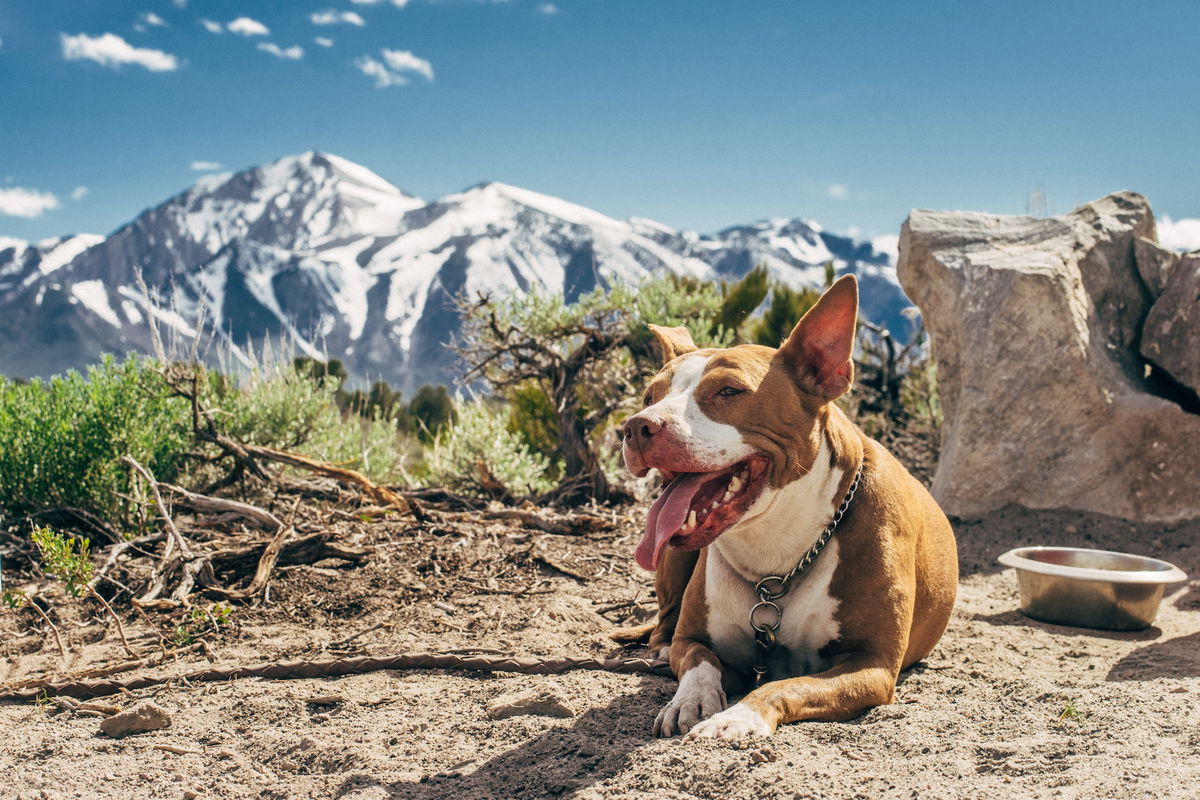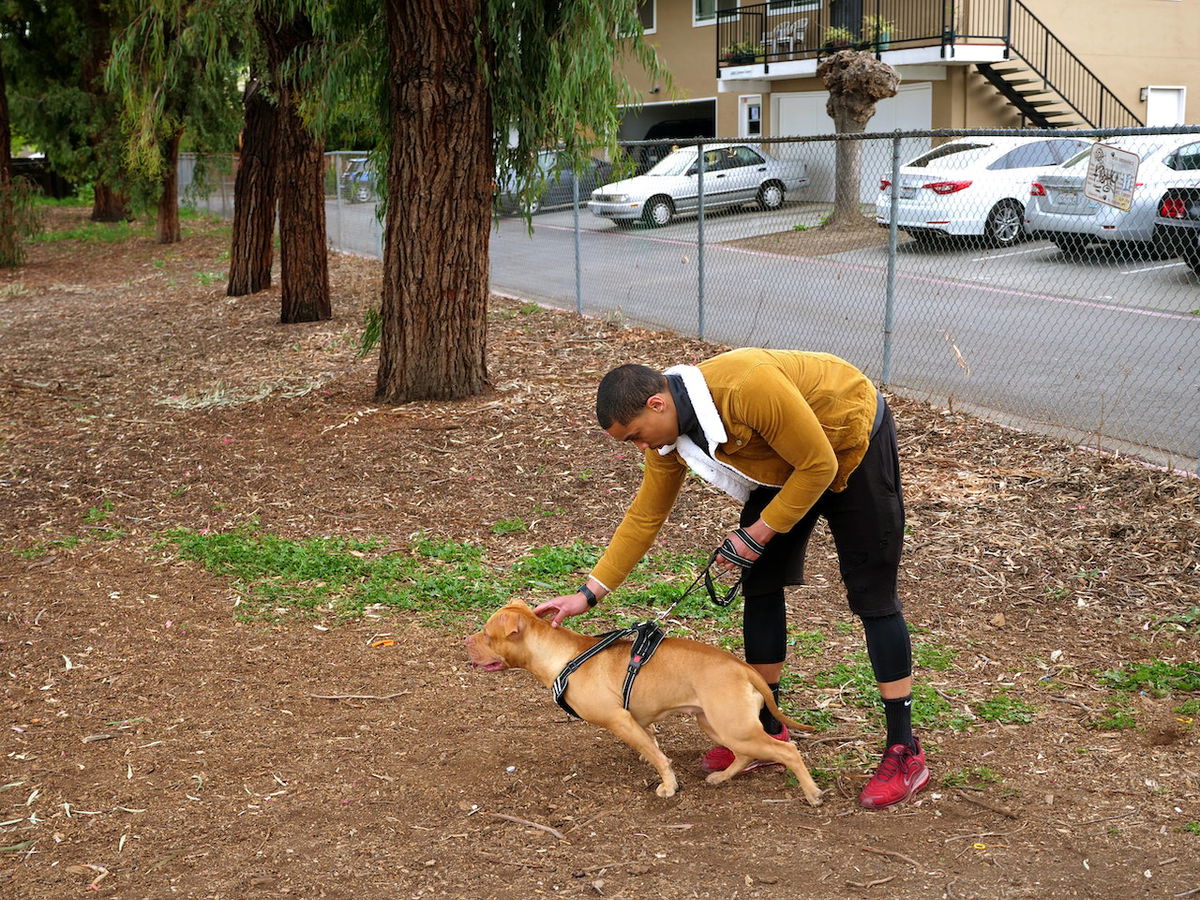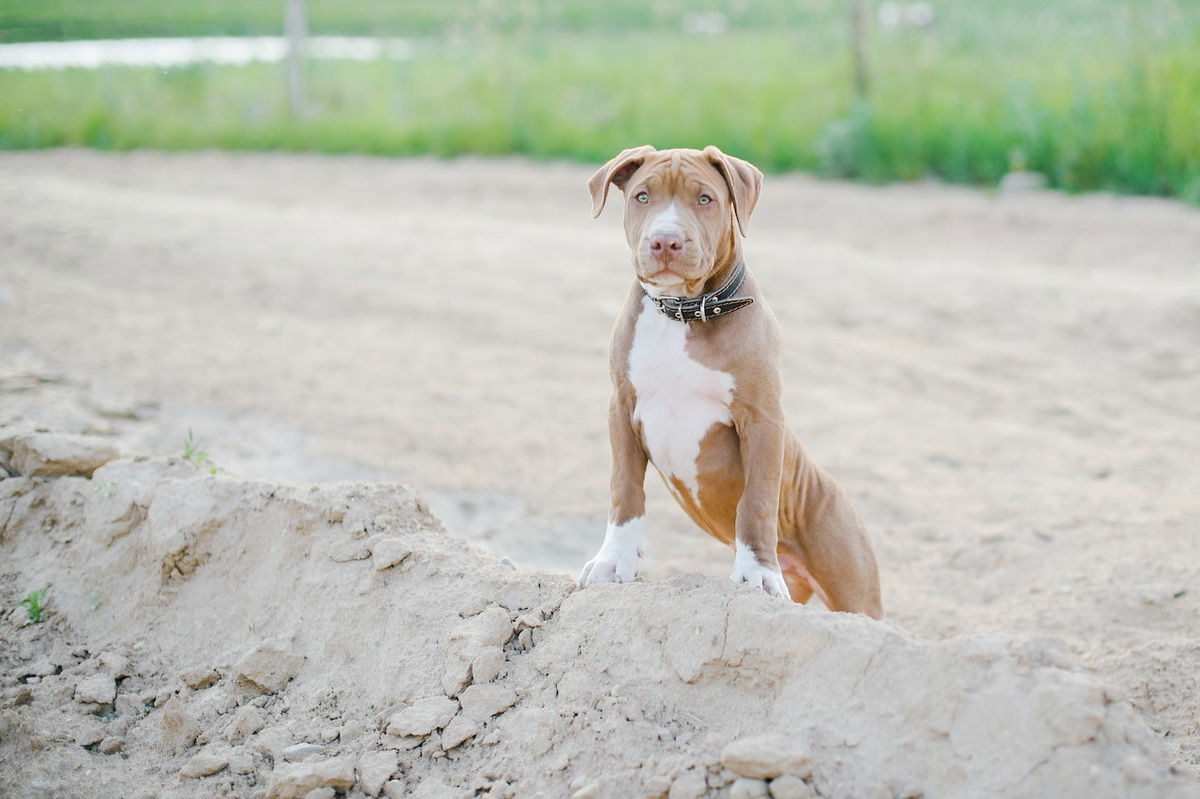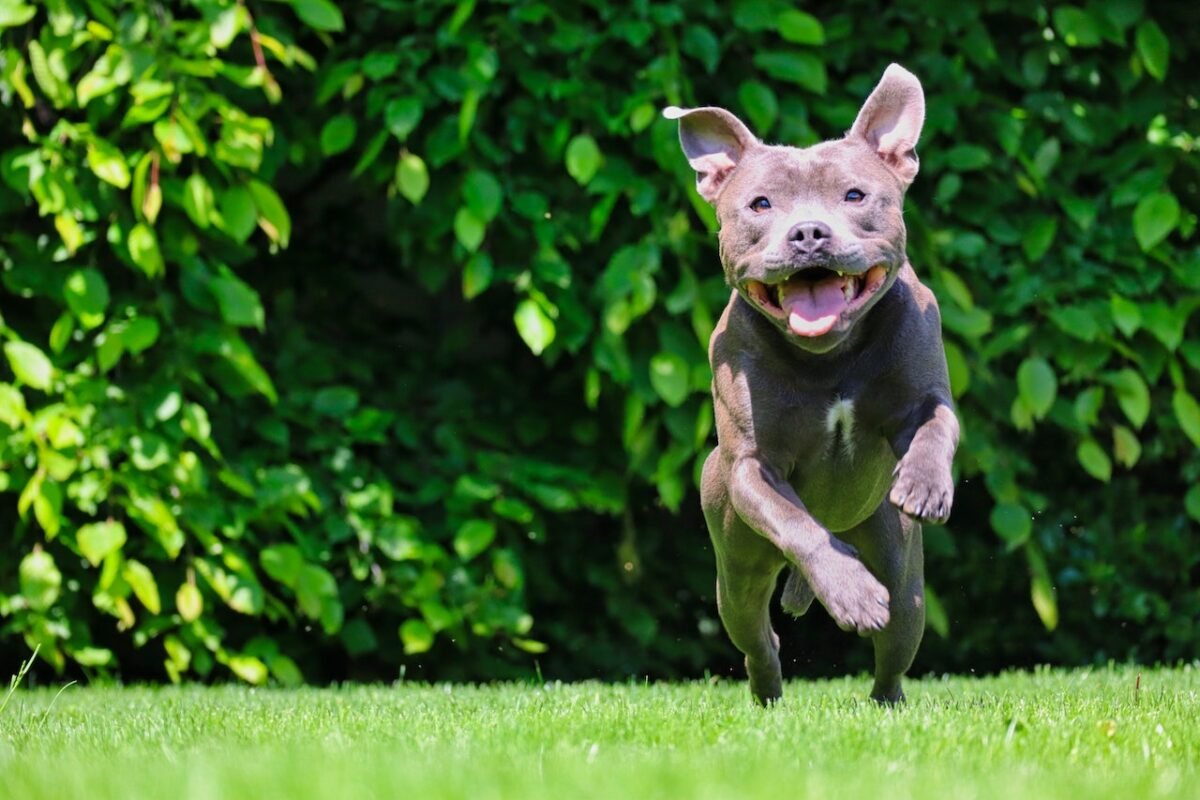We're an affiliate
We hope you love the products we recommend! Just so you know, we may collect a share of sales or other compensation from the links on this page at no additional cost to you. Thank you if you use our links, we really appreciate it!
As a Pitbull parent, you should aim to provide the best care for your muscular furry friend to keep them healthy and happy.
One of your major responsibilities is ensuring that your Pitbull’s physical health and mental well-being are in check by offering plenty of exercises.
But, just how much exercise does a Pitbull need? Are the short morning walks around your neighborhood enough, or should you make it a little more intense for your furry friend?
Pitbulls are loyal companions, sometimes stereotyped for aggressiveness because of their bold desire to take part in physical activities.
Join us in this post as we explore the importance of providing enough exercise for your Pitbull, and highlight how much exercise can be sufficient for Pitbulls throughout their life stages.
Understanding Pitbulls’ Exercise Needs
In the canine world, Pitbulls are known for their natural athleticism and devoted nature to take part in demanding physical activities.
These gentle giants are endowed with a muscular body build that sets them apart from most people-oriented dogs.
The natural desire to work and the inherent energetic nature of Pitbulls can be traced back to their original roles as working dogs.

Pitbull owners can attest to how these dogs are full of life and can thrive in various energy-demanding activities without breaking a sweat.
If you’re in search of a canine companion for your outdoor lifestyle, then you may be interested in adding a Pitbull to your family.
Regular exercises are therefore important for Pitbulls not only for their physical health but also as a way of relieving their boundless energy in positive outlets.
4 Factors Influencing Exercise Requirements in Pitbulls
Despite the overall high demand for an active lifestyle, there are several factors that may influence the exercise requirements for Pitbulls.
1. Age
One of the leading determining factors for exercise needs in dogs is age. Younger Pitbulls have higher energy levels and they will need more robust activities to fulfill their exercise demands.
Senior Pitbulls, on the other hand, may require lighter exercise or reduced energy-demanding activities to accommodate their aching joints and overall weakness.
2. Health
The health condition of your Pitbull has a direct relation to how much exercise you can offer them.
Pitbulls suffering from a health problem, especially those affecting mobility, will require a gentler approach when working them out.
Obese or underweight Pitbulls may have reduced tolerance to physical activities, due to lack of stamina from their already overwhelmed bodies.
3. Breed Type
The different dog breeds under the ‘Pitbull’ category may require varying amounts of physical activity because of their slight differences in energy levels.
American Bullies are more muscular than other Pitbull dogs, making them a good candidate for extended physical stimulation.
4. Temperament
The temperament of your specific dog can determine the period and extent of taking them out for exercises.
Some Pitbulls are naturally more hyper or active compared to others who may have a chilled-out demeanor and sloppy approach to physical activities.
Active Pitbulls may require intensified exercise activities and agility training, while their laid-back counterparts can be contented with regular walks around the block.
The Consequences of Insufficient Exercise
Working out your Pitbull by offering the right amount of exercise is not only about releasing pent-up energy but also has more to do with the dog’s overall health.
Failing to meet the exercise requirements of your beloved Pitbull may lead to several issues, some of which can be life-threatening.
Some of the potential problems of insufficient exercise in Pitbulls include obesity, developing negative behavior such as excessive chewing, potential health issues, and emotional issues such as anxiety.
How Much Exercise Does a Pitbull Need? Exercise Requirements for Different Life Stages
Owning a high-energy dog such as a Pitbull comes with a fair share of obligations for the pet parents.
Pitbulls were originally bred for bull-baiting, and some people used them for dog fighting when the former vice was banned.
Despite their negative bloody history, many Pitbulls enjoy taking part in positive dog sports such as playing fetch, frisbee, scent games, and agility training, among others.
It’s due to the inherent drive for vigor that Pitbulls require a tailored approach to providing exercise to cater to their specific needs.
The following are the exercise requirements for Pitbulls across various life stages:
1. Puppy stage (3 months – 5 months)
The first five months of your Pitbull’s life are critical for their optimal growth and development.
Pitbull puppies have a fragile body with developing bones and muscles, so you should not focus on straining activities.
You should rather make controlled exercise a top priority and focus more on brain work rather than draining physical workouts.
Pitbull puppies can do well with daily gentle walks around your backyard for about 10 to 15 minutes per day.
In addition to stimulating the young dog’s muscles, these walks will help them get accustomed to their new world and discover their surroundings.
It’s generally recommended to wait until your puppy is fully vaccinated before going outside for walks or socialization.
Before then, you can engage with your young Pitbull in interactive playtime by cuddling and offering them some toys.
Engaging your puppy’s brain from a young age will help stimulate their minds and make it easy to train them on obedience as they grow.
2. Adolescent Stage (6 months to 18 months)
A healthy teenage Pitbull may require between 60 to 90 minutes of exercise per day. The increase in exercise demand for youthful Pitties is occasioned by their upsurge in energy.

Youthful dogs are known to be active and full of life. You should channel the natural energy of a lively Pitbull to positive outlets such as brisk walking, playing fetch, and obedience training.
3. Adult stage (1.5 years to 7 years)
A fully grown healthy Pitbull can thrive on intensive exercises for between 1 or 2 hours per day.
The exact period of exercising your adult dog will vary depending on the several factors we highlighted in the previous section.
Exercising your Pitbull for 2 hours continuously may be overwhelming, it is, therefore, necessary to break it into practicable sessions throughout the day.
Some of the interesting activities you can offer your adult Pitbull include long walks across the neighborhood and the dog parks.
Don’t rush your Pitbull to walk faster. You should move at their pace and allow them to sniff the environment to their satisfaction.
Sniffing allows the dog to connect with the outside environment, in addition to building their senses.
Tagging your adult Pitbull for an evening jog is also an effective way of expending their day’s pent-up energy.
You can also speed up your dog to run during the jogging sessions but always watch out for the signs of fatigue.
Adult Pitbulls can also do very well in dog sports and obedience training. You can maximize their potential by setting up obstacles for agility training and teaching them some obedience knacks.
4. Senior stage (Above 7 years)
Your Pitbull’s natural energy will go down as they advance into senior years. Elderly Pitbulls are prone to joint issues and other degenerative conditions, making it hard to maintain an active life.
However, this does not mean that you stop providing exercise to your senior Pitbull. You just need to tone down the intensity and focus more on brain work rather than physical activities.
Senior Pitbulls can do well with a consistent exercise requirement of between 30 to 45 minutes per day, split into manageable sessions.
Some of the activities to consider for a senior Pitbull include gentle strolls throughout the week to keep their joints active and periodic swimming for a low-impact full-body workout.
Challenging your elderly Pitbull’s brain by offering Puzzle toys is a great way of exercising their brain to slow down canine cognitive dysfunction (the dog’s version of Alzheimer’s disease).
How to Incorporate Mental Stimulation Exercises
Pitbulls are intelligent dogs and therefore they need to be mentally stimulated to keep them in optimum conditions.
Adding brain games to your dog’s daily exercise routine is a good way of ensuring they get a whole-rounded package for overall wellness.
Mental stimulation is also crucial in ensuring your Pitbull is relieved from boredom and other emotional conditions such as stress and anxiety.
Games that require an intellectual approach from your Pitbull can be tiring since they provide a positive avenue for channeling excess energy.
Consequently, a mentally stimulated Pitbull is a tired dog! This means that they are less likely to engage in negative behaviors such as destructive chewing, digging, and excessive barking.
Some of the brain games to provide sufficient mental stimulation to Pitbulls include:
- Puzzle toys
- Scent games
- Obedience training
- Interactive play
- Social training
- Trick training
How To Create a Balanced Exercise Routine for Your Pitbull
Working out a tailored exercise routine for your beloved Pitbull is crucial for their optimal physical health and overall mental well-being.
You should not offer your dog a single type of exercise every time you step out. Some Pitbull parents find it easy to rely on walks or runs as the only way of exercising their furry companions.
We recommend that you be creative and broaden your dog’s exercise routine to ensure they receive the most from every activity.
The Importance of variety in exercise
Changing your dog’s activities throughout the week can help prevent burnout in addition to enriching different physical and mental aspects.
Providing your dog with the same activities on repetition can actually cause problems because they will use the same muscle group every time, leading to adaptive resistance.

Varying your dog’s physical activities helps tap into various muscle groups to enhance the body’s frame and maintain a healthier weight.
Rotating your Pitbull’s physical activities every so often can also reduce the risk of suffering injuries from monotonous procedures over and above preventing boredom.
Sample weekly exercise routine for different life stages
The following is a classic guideline you can use for providing your Pitbull with enough exercise throughout the week.
Keep in mind that these are just guiding principles, so feel free to fine-tune any part according to your dog’s need, but make sure not to push them too hard.
1. Puppies
Begin with short walks around your backyard for about 5 minutes and gradually increase the time to 15 minutes per session.
Engage with your young Pitbull in an interactive game session for about 10 minutes in one exercise shift before allowing them to cool down.
Start training your dog early enough to respond to basic commands such as come, stop, or sit and stay. Make sure to cap your puppy’s exercise time to a maximum of 15 minutes per day.
2. Adolescents
Take your youthful Pitbull out for brisk walking for about 30 minutes in the morning or in the evening when the sun is setting.
Set aside some 15 minutes to play fetch, which instills obedience behavior in your growing dog and teaches them to follow a target.
Play gentle tug of war with your youthful dog and allow them to win most of the time.
A periodic round of 15-minute water games or swimming to help your dog get a full body workout without straining.
Take your dog to the dog park at least once a week for a full hour of off-leash playing and interaction with other dogs and people.
3. Adult stage
Tag your grown-up Pitbull for morning jogs or runs and encourage them to sprint once in a while when the road is clear.
Start agility training by adding obstacles in your dog’s way and teaching them to overcome them for about 45 minutes per session.
Take your Pitbull for a full hour of hiking and trail walking in the woodlands, preferably during the weekends.
Let your adult Pitbull work for food by providing puzzle toys or treat-dispensing toys during lunch hour.
4. Senior stage
Focus on gentle slow-paced strolls around your neighborhood for about 15 minutes per session.
Take your elderly dog for swimming sessions for about 30 minutes to provide a low-impact full-body workout.
Gentle stretching during petting for about 10 minutes to ease pains in the joints.
Offer puzzle toys for reward feeding and mental stimulation.
Join your senior Pitbull in interactive games for improved social bonding and to exercise their brain.
As you mix the exercise throughout the day, you should remember the duration and always watch out for the signs of fatigue.
Outdoor vs. Indoor Exercise
Both outdoor and indoor exercises for Pitbulls have their set of advantages and drawbacks.
As a caring dog owner, you should find the perfect balance between in-house and open-air exercise for keeping your furry friend contented and healthy.
Advantages of Outdoor exercises
1. Fresh air
One of the major benefits of taking your dog outside for a routine workout is the provision of fresh air and environmental enrichment.
Open spaces give your pooch a chance to explore the natural climatic conditions including a fresh supply of clean air, natural sunshine, and the golden opportunity to sniff during walks.
2. Socialization opportunities
Walking your dog in open spaces gives them a chance to meet people and socialize with a variety of other animals.
Social training helps dogs ease emotional distress and instill good social behavior which helps to make a better all-rounded furry companion.
3. Space to run and play
The amount of space in outdoor settings is immense for dogs to run and play without feeling restrained.
Pitbulls are high-energy dogs and they need time to engage in physically demanding activities from time to time.

However, there’s a catch here. Don’t let your dog walk freely in a busy environment with human traffic and cars.
You should only let the leash off your Pitbull when visiting a dog-friendly park with minimum hazards for the dog’s safety.
Advantages of Indoor exercises
1. Weather independence
Exercising your Pitbull in the open allows them to enjoy a fresh supply of clean air and experience enriching environments.
This can be limited during extreme weather conditions such as hot weather, excessive wind, snow, or heavy rainfall.
Taking your dog out during the peak of summer can lead to heat strokes, and on the other extreme, walking on icy roads can cause your dog to slide and get injured.
Indoor exercise is a great alternative for achieving your dog’s exercise demands without exposing them to unforgiving weather.
2. Controlled environment
Nothing beats the peace of mind, knowing that you’re exercising your dog in a controlled or restricted environment.
That’s exactly what you get when exercising your dog within the confines of your home. A controlled environment allows you to closely monitor your dog throughout the session.
It’s much easier to allow your dog some rest when playing fetch within your house than doing the same in outdoor settings.
A controlled environment also makes it much easier to train your dog on command or when introducing new exercise routines.
3. Indoor games
The other huge benefit of exercising your dog at home is the ability to play indoor games with comfort and peace of mind.
Puzzle games, interactive plays, hide and seek, tug of war, or agility courses can be beneficial to dogs when offered within confined areas.
Indoor games also add some mental stimulation to your dog, driving out boredom and preventing them from developing negative habits.
Frequently Asked Questions (FAQs)
1. How often should I exercise my Pitbull?
On average, a healthy adult Pitbull may need regular exercise for around 1 or 2 hours per day for their overall physical health and mental well-being.
Puppies and senior Pitbulls may require a reduced amount of physically straining exercise because of their fragile bones and weak joints.
Adolescents and young adult Pitbulls can thrive on rigorous physical exercise every day, but make sure to watch out for signs of fatigue to avoid hurting your dog.
2. What are the signs that my Pitbull isn’t getting enough exercise?
If you don’t meet the daily exercise requirements for your Pitbull, they are likely to have a build-up of excess energy which can be channeled into destructive behavior such as excessive chewing and digging.
A Pitbull with a desire to exercise can also bark or whine while facing the door as a way of signaling their need to walk out.
In terms of physical appearance, a sedentary Pitbull can have excessive weight gain especially when combined with excessive intake of carbs and unhealthy fats.
3. Can I over-exercise my Pitbull?
Yes, you can over-exercise a Pitbull! Despite their robust body structure and heavy muscles, Pitbulls can also get fatigued by heavy exercise.
Don’t push your Pitbull to the limits and always watch out for the telling signs of exhaustion before overpowering them with too many activities.
4. Is walking enough exercise for a Pitbull?
Gentle walking can be enough for puppies and senior Pitbulls, but not for those young adults in their prime years.
Don’t get us wrong! Walking is an excellent exercise for working out your dog’s muscles, but it should also set a base for other movements, especially for high-energy Pitbulls.
You can also include running, playing fetch, agility training, interactive play, or swimming to ensure your Pitbull gets enough physical and mental stimulation.
5. How long should a pitbull be walked?
On average, healthy Pitbulls can be walked for about 30 to 45 minutes every day depending on several factors including terrain, health, and age.
Some robust Pitbulls can endure an all-day walk, but we recommend sticking to a maximum of 2 hours per session to prevent over-excitement and reduce monotony.
Conclusion
Pitbulls are muscular dogs with naturally high energy levels making them excel in physical activities without straining too much.
Depending on the exact Pitbull breed and age, these dogs need plenty of physical exercises and brain games to stay healthy.
Just to make a quick sum up, most healthy adult Pitbulls have the stamina to endure exercises for around 1 to 2 hours per day.
We recommend breaking the workout period into manageable sessions throughout the day and including a variety of techniques to ensure your Pitbull gets a balanced workout.
Puppies and senior Pitbulls don’t have the resilience to bear demanding physical activities, so make sure to reduce their workout time and intensity.
Keep in mind that your dog should get enough mental stimulation to balance the physical workout for better results on their health.
Laura is the founder of Furs'n'Paws. She is a also a pet writer and expert with more than 20 years of experience of working with dogs and cats. She developed a very strong love for animals at a young age. Her passion led her to establish a thriving pet sitting and dog walking business in Dubai. As an expert in pet training, behavior, and nutrition, Laura is committed to helping pet owners and pet lovers by offering high-quality information on a wide range of topics.



No responses yet